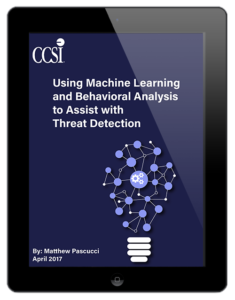The future of a wide variety of industries is being shaped by the advent of Artificial Intelligence (AI) in technological processes that previously took massive amounts of manpower and attention to detail. The automation of these processes through AI techniques like Machine Learning is a big win for cybersecurity, where they can help catch and prevent all kinds of cyberattacks.
While Machine Learning isn’t quite the same as AI as it is often understood, both systems allow computer processes to learn as a human would in order to compute complex processes at a scale no human could achieve. Arguably nowhere is this more important than in the ever-growing world of cybersecurity.
Here, we explore what machine learning is and how it stands to benefit cybersecurity practices.
Machine Learning vs. AI: What’s the difference?
In the world of artificial intelligence, the term AI is used to broadly describe the ability of a computer process to carry out functions that mimic human thought. This can be anything from how video game characters react to a player to the complex algorithms that create “deepfakes.” AI represents a wide spectrum of digital processing with perhaps the furthest reach of the technology being the sentient computer you might think of as HAL from 2001: A Space Odyssey.
In reality, while not quite sentient, AI technologies have gained the ability to learn in the form of Machine Learning. This is the name for the concept of giving an Artificial Intelligence system enough data that it begins to learn for itself, imitating patterns both natural and manmade to execute functions like never before. This is vital in data analysis and cybersecurity specifically, where the AI can change its own programming through Machine Learning to accommodate a change in its data environment.
So while AI is the broad category that encompasses Machine Learning, Machine Learning represents the specific process of a computer system adapting without being specifically told to do so by a programmer. The uses and implications of this technology are immense for the future of AI in cybersecurity.
Machine Learning in Cybersecurity
The role of Machine Learning in protecting people’s data in a digital world is growing all the time, and for good reason. Machine Learning is capable of constantly analyzing immense amounts of data in order to detect any kind of malware or virus that could indicate a security breach, then adjusting to protect against them.
Here are just some of the benefits Machine Learning offers cybersecurity for businesses and consumers:
- Thorough, hands-off system scanning for data breaches, malware, and more
- Endpoint protection through quick remediation
- Fast analysis of large amounts of data
- Adjustments without the need for expert input
These benefits of Machine Learning for business operations enhance the security of data with fast and effective monitoring and prevention of cybersecurity breaches. Without Machine Learning, cybersecurity programs take time to catch and resolve. Security experts can’t monitor systems on the scale that Machine Learning AI can.
The length of time it takes companies to catch these issues puts vulnerable data at risk. The Ponemon Institute found that the average time to identify and contain a data breach for a U.S. company was 279 days. That’s a lot of time in which attackers can steal and sell user data.
With Machine Learning paired with the skill of expert analysts, the time it takes to catch and prevent attacks can be reduced to as little as 30 minutes. This is especially vital in the healthcare industry, where cyberattacks occur with higher frequency and do more damage than in many other sectors. The same Ponemon Institute study, conducted for IBM, found that the average cost of a data breach is $3.9 million, with healthcare being the most costly industry.
Threats in the digital world evolve so quickly that no amount of training and manpower can effectively catch them all. But cybersecurity protections through Machine Learning can use the vast amounts of data put into them to develop better and better understandings of a system over time and adapt to better protect vulnerable data.
Machine Learning in cybersecurity puts a defense system at an advantage over others. Helping systems adapt with intelligent updates and corrections is an invaluable protection against malware and ransomware at the beginning and endpoint stages of cybersecurity.
An Intelligent Future for Cybersecurity
May 2017 saw the largest cybercriminal attack in history, an event that spanned 150 countries, and involved stolen healthcare data and ransomware. Criminals adapt just as security measures adapt, and while no cybersecurity system is impenetrable, Machine Learning systems offer the ability for defense programs to adapt to their attackers.
In a world in which private data is increasingly maintained in an online environment, it is vital to develop cybersecurity solutions that will keep companies and individuals safe. From protecting patient data to stopping cybercriminals, at the door, the benefits of Machine Learning in cybersecurity are limitless.
Using Machine Learning and Behavioral Analysis to Assist with Threat Detection
Attackers are consistently breaching enterprise networks in attempts to compromise confidential data and the hard truth is they’re not slowing down. Data breaches have almost become common place in today’s news and we’ve seen businesses hit with attacks that cost them millions of dollars in lost revenue, fines and consumer trust. The majority of these organizations already had the traditional security commodities in place (e.g. Logging, firewall, SIEM) and yet was still breached by dedicated attackers. In today’s attack landscape advanced attackers are able to bypass many of these defenses with persistent and dedicated attacks directed towards the organizations user base and vulnerabilities within their security architecture. The unfortunate truth when using only traditional security defenses is that the odds are heavily weighted in the attackers favor. By adding behavioral analysis and machine learning to a business’s cyber defense brings visibility to threats, which are sorely needed in today’s networks.
Author Bio: Jori Hamilton is an experienced writer from the Northwestern U.S. She covers a wide range of topics but takes a particular interest in topics related to technology, AI, Machine Learning, and Cybersecurity. If she’s not writing, she enjoys traveling the U.S. and being curled up in a blanket, reading a good book. You can follow her on Twitter and LinkedIn.
Jori is a guest blogger. All opinions are her own.
The post What is Machine Learning and How Does It Benefit Cybersecurity? appeared first on CCSI.
*** This is a Security Bloggers Network syndicated blog from CCSI authored by Guest Author. Read the original post at: https://www.ccsinet.com/blog/machine-learning-cybersecurity/
"machine" - Google News
August 18, 2020 at 03:59PM
https://ift.tt/2FD7LKZ
What is Machine Learning and How Does It Benefit Cybersecurity? - Security Boulevard
"machine" - Google News
https://ift.tt/2VUJ7uS
https://ift.tt/2SvsFPt
Bagikan Berita Ini
















0 Response to "What is Machine Learning and How Does It Benefit Cybersecurity? - Security Boulevard"
Post a Comment